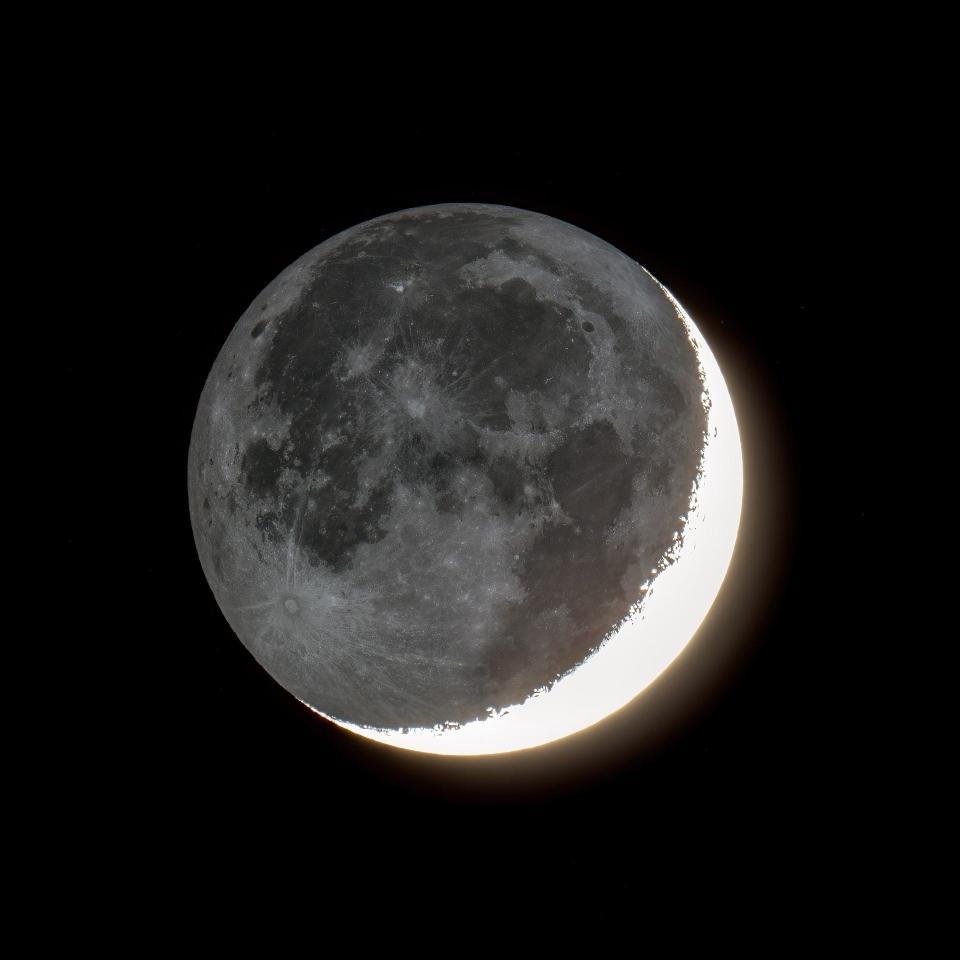Backyard Universe: Earth lights up the crescent moon
There’s something mesmerizing about a slim crescent moon hanging low in the sky at dusk or dawn.
It lacks the brilliancy of a full moon or the high altitude above the horizon where we find an evening first quarter moon a week after new moon.
More: Backyard Universe: Cool astronomical events slated for 2024 include a total solar eclipse
The slim crescent moon features a special lighting effect that makes it even more interesting, particularly when observed through binoculars or a telescope.
While the slim sliver of a crescent is most obvious, we can also see the rest of the moon’s face but it’s dimly illuminated. Our grandparents may have called it “The old moon in the new moon’s arms”
Earthshine
Sure most folks understand that the bright crescent shape is lit up by sunlight, but where is that weaker illumination coming from?
It’s coming from sunlight too, but that sunlight is making a detour before it hits the moon.

That dim illumination on the “dark side” of the crescent moon is caused by “earthshine” or sunlight reflected off Earth.
An astronaut standing on the earthward-facing side of the moon when it’s a slim crescent would see a nearly full Earth in the lunar sky. That Earth would appear four times larger and about 50 times brighter than the moon appears to us as seen from Earth. That nearly full Earth would be so bright it would be flooding the lunar landscape with its light, even if that part of the moon isn’t illuminated by direct sunlight.
Ode to Leonardo
Earthshine has been around as long as the moon and Earth have but it took awhile for humans to understand the cause of it.
Leonardo Da Vinci, that 16th century Italian renaissance painter, architect, engineer and scientist, was one of the first to offer an explanation for the faint light glowing on the crescent moon’s “dark side.” He showed that the light came from sunlight bouncing of the clouds and oceans of our planet. Most of the reflected light comes from clouds covering portions of Earth, and earthshine can appear brighter when there are lots of bright white clouds on the moonward side of Earth.
Leonardo’s explanations is noted today hundreds of years later as the phenomena is sometimes called the “da Vinci glow”.
When to check it out
Regardless of what we call it, the effect can be best be seen when the moon is a slim waxing or waning crescent, usually 1-3 days after or before new moon.
The next opportunity comes on the evenings of Feb. 11 and 12 when the slim moon will hang over in the southwest as darkness falls. On the mornings of March 7 and 8, a waning slim crescent moon will display earthshine as it hangs over in the southeastern sky at dawn.
The “fatter” the crescent moon the less earthshine we see. The bright sunlit part of the moon appears larger and brighter, washing out the fainter earthshine. At the same time the phase of Earth as seen from the moon is shrinking, making the reflected light from Earth less bright.
After all these years of watching the sky, I never grow tired of catching a binocular or telescope view of a slim crescent moon awash with that da Vinci glow. I think it gives the moon a 3-D effect like no other phase.
Speaking of “all these years,” 2024 marks the 35th year of the Backyard Universe column in The Fayetteville Observer. The monthly column started in January 1989 after I approached Observer features editor Mike Arnholt about writing it weekly. “Let’s try once a month,” he said. That advice was good, just like Mike’s advice on lots decisions made in the Observer newsroom as he became editor in later years.
I hope the column has prompted some of you to take a few skyward gazes on clear nights. Going forward, I’ll try not to miss many clear nights…or writing about what we can all see by just looking up.
If you have a question about astronomy send it to Backyard Universe, P.O. Box 297 Stedman, NC 28391 or email johnnyhorne937@gmail.com.
This article originally appeared on The Fayetteville Observer: Slim crescent: The old moon in the new moon’s arms

